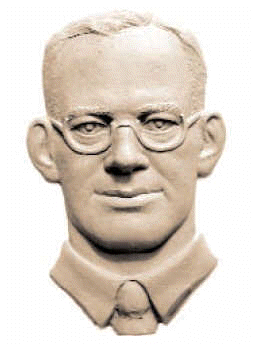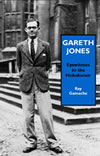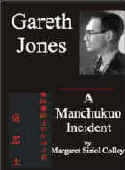Gareth Jones
[bas relief by Oleh Lesiuk]
HOME |
Stop Press |
Complete Soviet Articles & Background Information |
Précis of Gareth's
|
All Published Articles |
BOOKS
|
|
|
|
More Than Grain of Truth(2005) |
|
|
TOPICAL
'Are you Listening NYT?' U.N. Speech - Nov 2009 |
Gareth Recognised at Cambridge - Nov 2009 |
Reporter and the Genocide - Rome, March 2009 |
Order of Freedom Award -Nov 2008 |
Premiere of 'The Living' Documentary Kyiv - Nov 2008 |
Gareth Jones 'Famine' Diaries - Chicago 2008 |
Aberystwyth Memorial Plaque 2006 |
GENERAL
Scholarship Fund |
Site Map |
Links |
Legal Notices |
Sponsored Links |
Contact |
|
||
|
By Gareth Jones SUNDAY was nearly over and the deacon sat in the armchair before the fire. The young ministerial student had preached well - a little too modern, perhaps, but well - and had left the village to tramp over the mountain to Llanarmon-Dyffryn-Ceiriog. Sunday school had been that afternoon stimulating. A youngster from a farm a mile away had thrown out a challenge: “You have been a deacon for forty years. What good has religion done to the LIan?“ This question was raised at tea and the ministerial had spoken in the same doubtful tone as the youth from the farm. What good, indeed, had religion done to the LIan? Here was a challenge over which the deacon would have to ponder, and that quiet hour on Sunday night between supper and bed-time seemed to him fitted to be devoted to a meditation on his forty years in the “set fawr.” Had his efforts in the village been worthwhile? He had been a fighter—sincere, almost fanatical— against the taverns. Many a dash had he had against the innkeepers: many a battle for the sobriety and morality of the Llan. Had they availed? He had struggled for the deepening of religious life in the village. Had that struggle availed? The deacon decided to journey back forty years and to compare the Llan of the ‘eighties and the ‘nineties with that of today. He would draw a balance sheet of the losses and achievements in that period. What of the losses? He thought of the preachers of the last century. What giants they were I Men whose words shook the souls of their congregation. Men who terrified you with their dignity as they stood in the pulpit. Men whose theology was based on years of deep thought. Men of philosophy. Men who stood firm by their dogmas and their doctrines. Those were the preachers of yesterday. And they knew that a sermon was a sermon. None of your snippety little chats, but a full-blooded hour’s dissertation at least. At the “cyfarfod misol” there used to be two sermons instead of the one they had nowadays—thundering sermons, with a powerful “hwyl.” What a downfall there had been in the preachers, thought the deacon. Instead of the giants whose philosophy and dignity made them objects of awe, you had young preachers who were more egoistical, more self-controlled, more confident, and who thought they knew everything. These youths of today neglected theology, they scorned dogmas, they were not firm in their beliefs, and had given up the “hwyl” for a quiet reasoning which affected the head but left the heart untouched. They thought that half-an-hour was quite long enough for the sermon, and you never felt that spiritual uplifting after you had listened to them. Thus the deacon thought. What of the Sunday school? he next asked himself. He was perturbed about this side of his religious life. Whereas forty years ago there were 130 members of the Sunday school, now there were only 50. The children recited less; they did not know their Bible at all thoroughly. Perhaps they were taught a more practical religion today, but, reflected the deacon, what is the use of practical religion without dogma and without a foundation of theology? The deacon grew depressed. He thought that religion was failing. That belief in God was disappearing. He looked round for guidance to the pictures of the Nonconformist giants on the walls. Was there no consolation? The deacon searched for the achievements and he brightened. What of temperance and morality? He recollected the terror with which Saturday night in the LIan inspired him. On that evening of the week rowdyism descended upon the village. And the fighting I Many of the farm labourers only came in to the LIan to fight. How they would rush madly at their enemies I To what bloodshed the feuds would lead! It was no boxing match but a savage struggle. That was the Welsh villager’s Saturday night forty years ago, thought the deacon. Where was the fighting today? At nine o’clock there was hardly a sound on the town square. Many taverns had been closed. The Sun had become a temperance hotel. The fairs were no longer the cat-and-dog fights of forty years ago. No, thought the deacon, the Llan is better. Why? And when did this happen? His mind went back to 1904-5, to the Revival. It was then that the great change had come. It had been for the Llan the most stirring time of its history. The chapels had filled to overflowing, and the taverns had been neglected. The Revival had brought the victory of religion and morality over the evil forces of disorder. The deacon looked at the clock. It was midnight. He rose slowly. He was a happier man. He felt that his forty years’ struggle in the LIan had seen a revolution in the habits of the villagers. They might not know their Bible so thoroughly as they used to, but they had become peaceful, God-fearing citizens, leading lives of order and morality. As the deacon climbed the stairs he smiled and thought, “When those youths ask me what religion has done for the Llan, what a thundering reply I shall be able to give them!” January 5th, 1934. |
GARETH JONES (1905 -35) |




